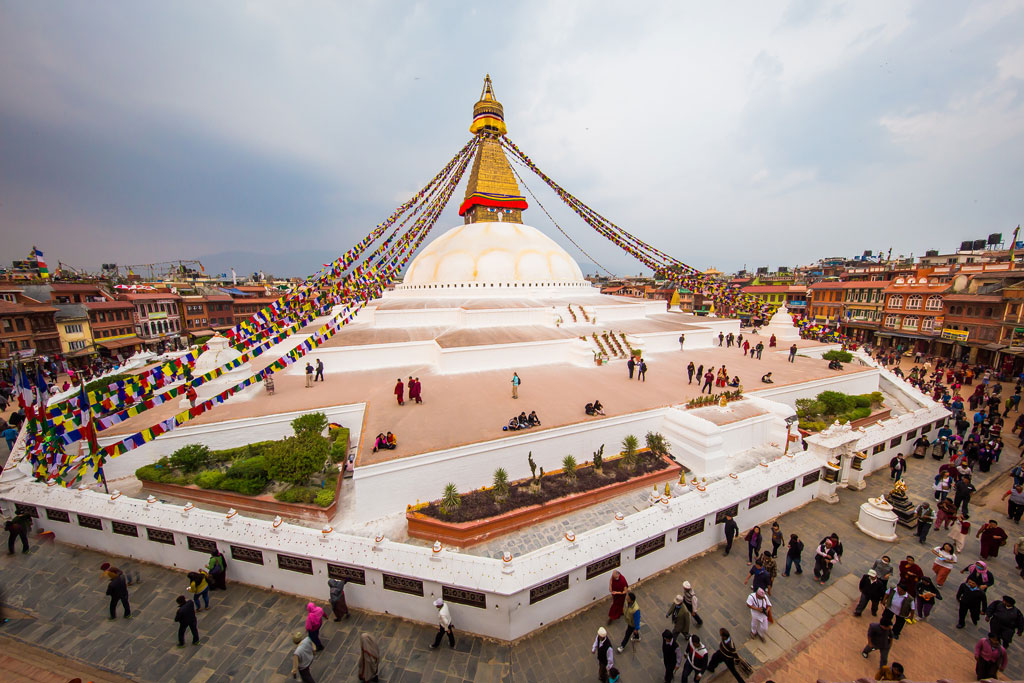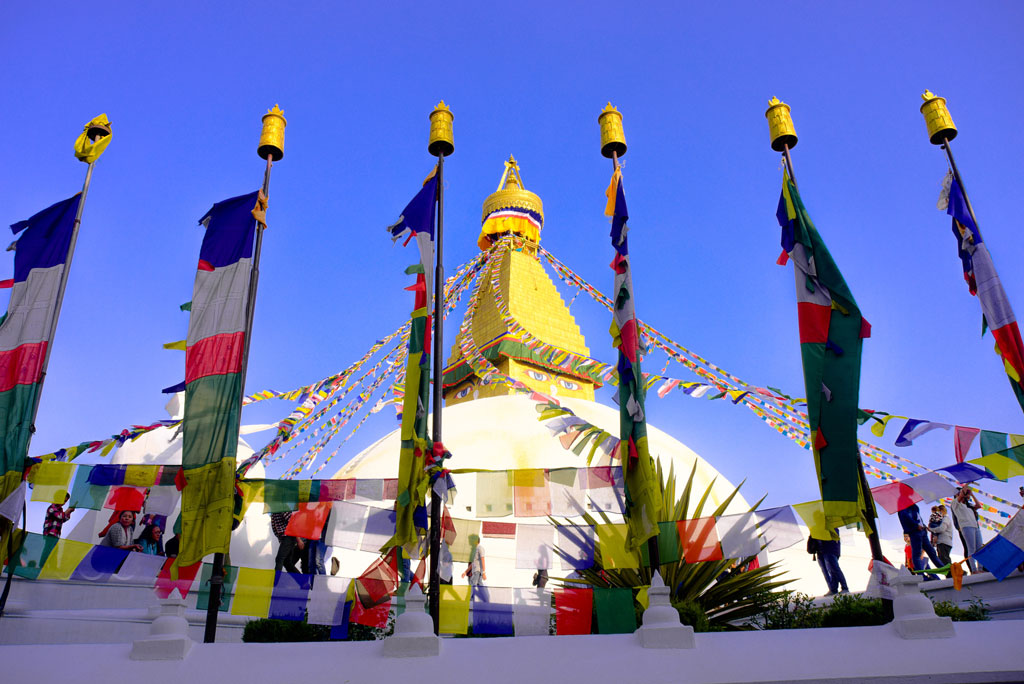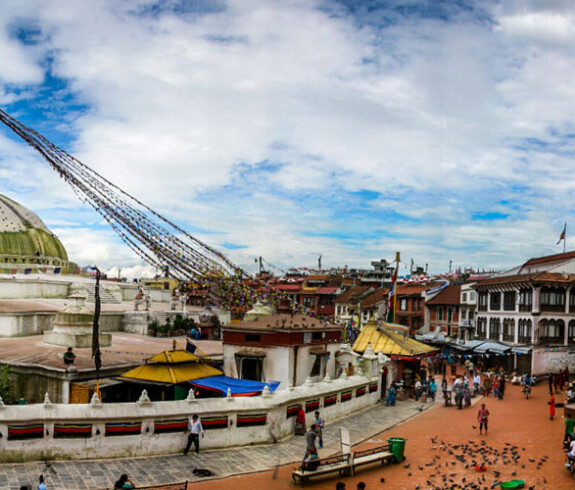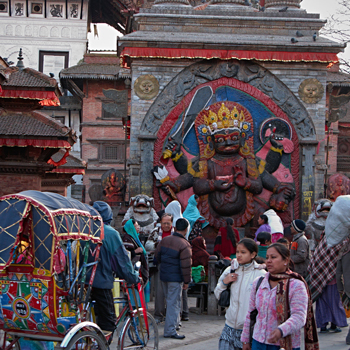Buddhists congregate around the Boudhanath stupa. It is called བྱ་རུང་ཁ་ཤོར། (Jarung Khashor) in the Tibetan Language. It is one of the main attractions and precious temples, attracting Buddhists from all over the world. It’s only about 5 kilometers from Kathmandu’s downtown area. The serenity and insight of this Stupa reflect in its design.
Similarly, all tourists to Kathmandu must visit this place. It is also the most prestigious Tibetan Buddhist temple in Tibet as of 1979. It is also a UNESCO World Heritage Site.
The Stupa’s large, hemispheric white crown and high spire make it easy to distinguish. Also etched on each side are four unblinking eyes that stare in all directions. The overall form is a Buddhist mandala depicting the journey to enlightenment.
History of Boudhanath Stupa
The history of Boudhanath is fascinating and enigmatic. This Stupa comes behind with several sating and myths. The exquisite Stupa’s tale is reflected in the artwork. The Tibetan version is likely the most famous of the many stories concerning its birth.
Boudhanath’s first Stupa was erected after the year 600. It was constructed after Songtsen Gampo, the Tibetan ruler, adhered to Buddhism. No other monument in Nepal compares to Boudhanath regarding the majesty and delicacy of line.
The monument is precisely proportioned, from its alabaster crown to its glittering structure with the Buddha’s all-seeing eyes.
According to Locals, a Buddhist shrine was built here years ago by an older woman affected by it. Furthermore, a woman requested the monarch for land, which he refused to approve.
Moreover, The Bodhisattvas, on the other hand, stepped within him and made him do it. Similarly, the woman started constructing the dome, which her four sons concluded.
This clarifies Boudhanath’s proper and legal formation. It was done entirely in the 14th Century.

Architecture
It has a similar architecture and design to Swayambhunath. Furthermore, the particularly poignant structure functions as a three-dimensional structure in reality. It could serve as a reminder of the Buddha’s enlightenment journey.
Likewise, the tripod signifies soil, while the Kumbha represents water at the top. The harmonica that symbolizes a tower is also on fire.
Furthermore, the spire consists of air, and the umbrella at the apex represents the vacuum or ether that exists outside of space. The spire’s 13 levels represent the stages a person must go through to reach enlightenment.
In addition, stupas were initially built to contain holy relics. Furthermore, others allege that Boudhanath houses the relics of Buddha Kashyapa, who lived in the past. Others claim it contains a sliver of bone from Siddhartha Gautama’s skeleton.
Moreover, 108 miniature pictures of the Dhyani Buddha Amitabha are around the Stupa’s base. A ring with prayer wheels is also visible in teams of 4 or five.
Attractions of Boudhanath
You can witness several traditions resembling hotels and restaurants. Beautiful breakfasts and dinners are available. Similarly, Its tranquil atmosphere makes you feel content. This holy Stupa’s stunning design will take your breath away.
In addition, there are many monasteries in this area. The presence of pigeons further enhances Boudhanath. You can also acquire lovely handicrafts created by locals. Buddhists’ artistic side highlights the historical significance of tradition and their appreciation of it.
Furthermore, while visiting here, the gorgeous weather adds to the magnificence. There are several other places near the Stupa where you can chill out and have a good time.
What to do?
It is customary to only go clockwise around the Stupa with every other Buddhist stupa. Arriving at the main gate, travel about a third of the way around to find a crowd gathered around a modest shrine at the Stupa’s base.
Likewise, the entrance to the dome’s higher levels is just to the right of the shrine. You can stroll around the Stupa 360 degrees in absolute peace.
Look below you to observe novice Buddhists in training contemplating and meditating – most of them are Westerners learning at a local Buddhist monastery.
You can even participate and learn some meditation techniques. Furthermore, wander about and gain additional knowledge on anything. You can also examine other little figurines inside the Stupa.
Aside from that, several modest restaurants with spectacular views of the Stupa. In the streets near the Stupa, you’ll see a lot of international students dressed in maroon robes.
Also, make sure you have a healthy dosage of patience and understanding. Beautiful photographs of the Stupa and its surroundings are possible. These memories and moments will last a lifetime.
You may capture the time-lapse of people moving about similarly. Exploring Boudhanath Stupa will thus be one of the most memorable experiences.

Best time to Visit
Boudhanath is famous for its beaches around Losar. Sherpa people celebrate Lohsar, a holiday. You’ll also notice old Buddhists singing mantras and walking around Boudha Stupa.
On the day of Lohsar, there will also be a variety of diversions. Various arts and crafts are on sale. The skilled artist is well-versed in Buddhist culture. As a result, the handcrafts will always be unique and stunning.
Tranquility and beautiful vibes surround Boudhanath during Lohsar and other festivals. Also, visit Boudhanath at any time. Moreover, you can visit 24 hours, seven days a week. Exploring Boudhanath in fine weather will be ideal.
Take a trip to the monument during the Tibetan New Year’s festival of Lohsar to get a sense of the sanctity of the location. Buddha Jayanti is celebrated in February or March when the Buddha’s image is carried around the Stupa in a procession.
Similarly, Tamangs, the Stupa’s protectors, arrive to arrange weddings, and hundreds of brides wait around the Stupa inspecting potential husbands. It would help if you went at this time.
Within Buddhism, you can also see different castes and ethnic groups. In addition, the festival season is the perfect time to visit Boudhanath.
Furthermore, the atmosphere will be fantastic in the evening. It’s much more wonderful with the summer sky and the gentle breeze. Walking around Boudhanath, you can see mediations and get a nostalgic feeling.
Likewise, the small flags were strewn about add color to the beauty. The locals are also fairly amazing and extremely friendly. The time to visit Boudhanath Stupa is in the evening.
How to get to Boudhanath Stupa?
From Kathmandu, it’s simple to get to Boudhanath Stupa. It takes roughly three hours to travel there, explore for a while, and return.
You can also walk or utilize public transportation. It’s also a good idea to walk. Taxis are the most convenient mode of transport to Boudhanath. Taxis cost between 250 and 400 NPR on average.
Moreover, local buses will cost you 50-70 NPR. In the Kathmandu Valley, taxis are less expensive than buses. The bus journey from Thamel to Boudhanath will take approximately 35 minutes.
In contrast, a cab ride will take you 20 to 25 minutes. Likewise, getting to Boudhanath will not be challenging because it takes a good road, a short distance, and perfect transportation.
Entry fee
For international tourists, the entrance charge is NPR 400. The entrance fee for citizens of SAARC nations is NPR 100. It is also free for Nepalese citizens. The entrance charge is significantly lower than any other entrance fee.
Furthermore, there are no religious, racial, or cultural barriers.


